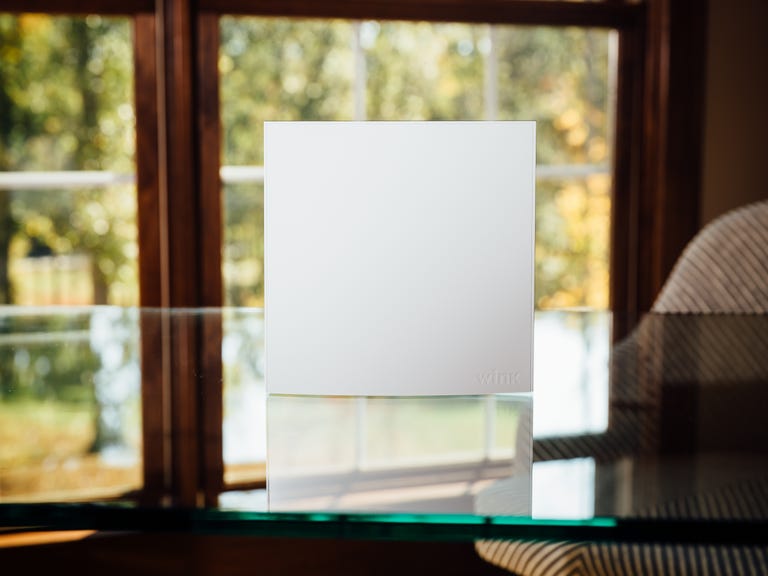 Why You Can Trust CNET
Why You Can Trust CNET Wink Hub 2 review: The Wink Hub 2 takes one step forward, two steps back
Wink made a lot of claims about its next-gen hub, but this version is frustratingly similar to the last.
Wink's Hub 2 gave me major deja vu. Not only does this slab of white plastic look very similar to the startup's first-generation Wink Hub, it also works roughly the same.
The Good
The Bad
The Bottom Line
That means you'll run into occasional in-app glitches, latency issues and connectivity woes. And, priced at $99/£80/AU$130, this smart home gizmo also costs $20 more than the original version.
Yes, Wink has made some improvements over generation one. Hub 2 has more memory, supports Bluetooth, comes with an Ethernet port and works with dual-band Wi-Fi. But that isn't enough to recommend it over the interactive voice-control platforms that have emerged since from Amazon and Apple.
A utilitarian hunk o' plastic
No one has found a truly engaging aesthetic for a smart-home hub and the white plastic Wink Hub 2 is no exception. While this model feels heavier and more durable than its predecessor, it isn't much of a design improvement. The two iterations have roughly the same measurements and they're, well, seriously boring-looking.
Instead, the most significant updates are hidden inside the hub itself. There you'll find 512 MB worth of memory (up from 64 MB), an Ethernet port for connecting the hub directly to your router and support for both 2.4 and 5GHz Wi-Fi, as well as Bluetooth-enabled devices.
Here's a list of the automation languages Wink's Hub 2 works with:
- Bluetooth LE
- Kidde
- Clear Connect
- Z-Wave
- ZigBee
Note: You can still buy the first-generation Wink Hub for $69/£55/AU$90 while supplies last.
View all of your Wink-connected devices from the app's home screen and select "Add a Product" to pair more.
Testing out Wink's new hub
All of those improvements are a step in the right direction, but I didn't notice any distinct differences between testing the first- and second-generation Wink Hubs.
The good news is that it's still (mostly) easy to pair devices. I connected a Nest Learning Thermostat, a Nest Cam Indoor, a Lutron Serena window shade and a Lutron Pico remote. I also connected to our Chamberlain MyQ Garage door opener account, but that product isn't currently installed at the CNET Smart Home so I couldn't actually control it.
Select "Add a Product" on the home screen and follow the detailed step-by-step instructions to connect that device.
This worked well, with one annoying caveat. I was having a lot of trouble connecting the Lutron Serena window shade and learned from a Wink representative that, "Wink-compatible products connected to other smart home platforms will need to first be unpaired before they can be used with Wink Hub 2."
Unpairing Lutron devices is extremely frustrating, since you have to triple press and hold the reset button and then quickly triple press it again. And if you don't get the timing just right, it won't work. It took me at least a dozen tries to reset it correctly. To its credit, the Wink app was clear about what I needed to do; it just wasn't easy.
Clicking on the "Thermostats" category or the "Blinds" category on the home screen would pull up the Nest thermostat or the Lutron Serena shade so I could view their current status and make any adjustments as needed. This worked pretty seamlessly, albeit with occasional lags.
The major problem I experienced related to Wink's robots or rules. These rules should let you create IFTTT-style automations like, "If my Nest Cam Indoor senses motion, then my Lutron Serena shade opens." Not only did this not work once, I got a consistent "500 Internal Server Error" that made me think I hadn't successfully created the rule. But, as it turned out, I had actually created multiple versions of the same rule -- and not one of them was working. Bummer.
I had so much trouble getting the rules feature to work, I ultimately gave up.
Of course, Wink's Hub 2 isn't the only hub that's run into trouble. We briefly championed Samsung's open-source SmartThings Hub, only to run into serious usability issues with the app. Insteon's Hub Pro and Iris by Lowe's also had some significant limitations.
And now, integrations via Amazon Alexa and Apple HomeKit make it possible to adjust the temperature of your thermostat, turn on lights, open shades and more all with a simple voice command to Alexa or Siri. I had high hopes for Wink's second hub, but Wink needed to go above and beyond to compete with the seamlessness of saying, "Alexa, set my thermostat to 68 degrees." Right now, it just doesn't -- especially since Wink increased the price of its hub from $80 to $99.
The verdict
With platforms like Amazon's Alexa and Apple's HomeKit swooping in with comparatively easy and fun ways to communicate with smart home gadgets, it's hard out there for traditional hubs. Yes, Wink has an Alexa Skill and HomeKit-enabled devices like Lutron's Serena shades work with Wink, but the Hub 2 comes across as more of a intermediary, and one that overcomplicates more than it simplifies.
If Wink manages to work out some of its performance kinks, the Hub 2 would make a fine smart home unifier for app loyalists. But personally, I'd reach for a $50 Amazon Echo Dot instead.


